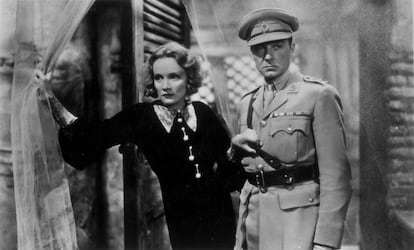The women from all walks of life who rebelled against the Nazis
An exhibition in Berlin pays tribute to the small acts of resistance by anonymous individuals of various social classes and ideologies who risked their lives to confront National Socialism


Sophie Scholl wrote one word on the back of the indictment that condemned her to death: “freedom.” The story of this university student who defended her ideas against Adolf Hitler’s regime is one of the most heartbreaking in Nazi Germany. The young woman was part of a group called the White Rose, which distributed leaflets with messages against the Third Reich until it was discovered by the Gestapo. All its members were sentenced to death by guillotine. Sophie was only 21 years old. Today, in practically every German city, there is a school named after her, as she has become a powerful symbol of peaceful resistance.
When Germans remember the women who rebelled against National Socialism, they think of Scholl, or Marlene Dietrich, the Hollywood star who used her fame to tell the world what kind of monster Hitler was. But there were hundreds of women from different social strata and ideologies who risked their lives to fight fascism. While the role of men in the resistance is very well documented, that of women has always been less known, something that Johannes Tuchel, director of the German Resistance Memorial Center, describes as “shameful for German historiography.” “After the war, the unwillingness of women to testify was compounded by a lack of interest on the part of academic research,” he notes.
The exhibition Women in Resistance against National Socialism, which will be on display in Berlin until November, is a way of settling this historical debt by bringing to the surface stories of women who had been forgotten. Their portraits are now displayed on the facade of the center, a monumental complex built by the Nazis off the beaten tourist track in Berlin. The symbolically charged building is the site where 80 years ago, Colonel Claus Schenk von Stauffenberg and other leaders of the failed July 1944 Operation Valkyrie conspiracy to assassinate Hitler were executed.
The comprehensive permanent exhibition is now joined by this exhibition, the result of a commission by the German parliament. In 2019, the Bundestag expressly recognized “the courage and achievements of women in the resistance against National Socialism” and earmarked funding for the laborious task of tracing and documenting thousands of life stories.

The women who fought in the resistance ranged from daughters of bankers and high-ranking military officers to teachers, secretaries, illustrators and domestic workers; from trade unionists, anarchists, communists, and socialists to Catholics, Protestants and Jehovah’s Witnesses. The exhibition includes 32 portraits representative of this diversity, while the Frauen im Widerstand website offers access to another 300, with photographs and preserved documentation including letters, postcards, or the court sentences against those who were arrested.
They were all united in their opposition to National Socialism, which sought to confine them to a life of subjugation. “National Socialist ideology reduced women to the role of mothers and housewives,” said State Secretary for Culture Claudia Roth at the inauguration of the exhibition: “They were supposed to stay away from politics, have children and raise them, and take care of the family. Leadership positions in the state, party, economy and society were reserved for men.” The exhibition displays propaganda from the Nazi era that extols the figure of the housewife and women’s work in factories, which became necessary when the men were at the front.
Standing up to the regime was doubly heroic for them. The housewife Elise Hampel, together with her husband Otto, spread hundreds of postcards all over Berlin denouncing Hitler’s government. Her case inspired the popular novel Alone in Berlin by Hans Fallada, which has been made into a film several times. Communist teacher Hilde Radusch and her severely disabled partner, Else Klopsch, defied the authorities by offering help to Jews.
Others participated in wider networks. Freya von Moltke, a banker’s daughter, worked with her husband in the Kreisau Circle, a group of socialists and conservatives discussing how Germany would be reorganized after the end of the Third Reich. Secretary Maria Terwiel, advertising illustrator Elisabeth Schumacher, secretary Rose Schlösinger, and Communist clerk Hilde Coppi (whose life was made into a film this year) collaborated with anti-Nazi resistance groups called the Red Orchestra, which incited civil disobedience, helped Jews and dissidents escape, and supplied information to the Allies.

Others simply made the fatal mistake of voicing their criticism of the Führer out loud. Like the seamstress Elfriede Scholz, sister of Erich Maria Remarque (author of the anti-war novel All Quiet on the Western Front, which was banned by the Nazis) and a staunch anti-Nazi who called German soldiers cattle for slaughter and wished death on Hitler while talking to a customer. Shortly afterwards, she was betrayed.
Marlene Dietrich was perhaps the resistance’s greatest international loudspeaker. She became a Hollywood icon and was tirelessly active against the Third Reich: she committed herself to the emigration of Jews and politically persecuted people and financed the fight against the Nazis. “Boys, don’t sacrifice yourselves! War is bullshit and Hitler is an idiot,” she told Wehrmacht soldiers in 1944.
“Resistance encompasses all actions aimed at damaging the National Socialist movement. This includes, for example, the writing or distribution of criticism, participation in banned parties and organizations, but also enthusiastic individual criticism and aid to Jewish victims,” says Dagmar Lieske, curator of the exhibition.
This romanticized image of women as guardians of the home was evidently limited to women who fit into the popular community, or Volksgemeinschaft, the ideal totalitarian society advocated by the Nazis. The rest were left out: both those who lived non-conformist lives and those who did not meet racial criteria. These — Jews, Gypsies, the disabled — were stripped of their rights and persecuted.
From the moment they came to power in 1933, the Nazis severely suppressed any form of political resistance and began sending communist, social democratic and trade unionist women to concentration camps. By 1945, civil courts and so-called people’s courts had handed down 15,000 death sentences, most of which were carried out.

The young stenographer Liselotte Hermann, arrested for supplying information to the outlawed Communist Party, was the first mother and resistance fighter to be beheaded in Berlin’s infamous Plötzensee prison in 1938. The exhibition also commemorates unknown figures, such as the number of women whose children were taken from them after being sentenced. Between 1939 and the end of the war, more than 120,000 women were confined in the Ravensbrück concentration camp. Over 25,000 died, either killed outright or from the inhumane living conditions.
Resistance activity became particularly dangerous from the winter of 1942-1943 onwards. The defeat of Reich troops by the Soviet army in the decisive Battle of Stalingrad marked a further escalation of repression in Germany. The Nazi leadership wanted to preserve internal stability at all costs.
“From that time on, most of the death sentences against women were for so-called subversion of the defense forces. In reality, behind this accusation was the ruthless suppression of any criticism of the system,” explains Tuchel. Activities that were previously punishable by imprisonment now carried the death penalty. This and other legal tricks were used to sentence them to death. In 1942, Schumacher was convicted and beheaded, followed in 1943 by Scholl, Hampel, Terwiel, Scholz, Coppi, and Schlösinger.
Others, such as Von Moltke, Radusch, and Klopsch, managed to avoid conviction or arrest. The aristocrat Erika von Tresckow, who collaborated with her husband General Henning von Tresckow in the Valkyrie conspiracy to assassinate Hitler, convinced the authorities that she knew nothing of the plot against the Führer.
For Roth, a member of the Greens, the example of the women in the exhibition is especially pertinent today in the face of those who use hate speech and fear to divide society: “These women challenge us to use our room for maneuver here and now to protect, defend, and preserve democracy.”
Sign up for our weekly newsletter to get more English-language news coverage from EL PAÍS USA Edition
Tu suscripción se está usando en otro dispositivo
¿Quieres añadir otro usuario a tu suscripción?
Si continúas leyendo en este dispositivo, no se podrá leer en el otro.
FlechaTu suscripción se está usando en otro dispositivo y solo puedes acceder a EL PAÍS desde un dispositivo a la vez.
Si quieres compartir tu cuenta, cambia tu suscripción a la modalidad Premium, así podrás añadir otro usuario. Cada uno accederá con su propia cuenta de email, lo que os permitirá personalizar vuestra experiencia en EL PAÍS.
¿Tienes una suscripción de empresa? Accede aquí para contratar más cuentas.
En el caso de no saber quién está usando tu cuenta, te recomendamos cambiar tu contraseña aquí.
Si decides continuar compartiendo tu cuenta, este mensaje se mostrará en tu dispositivo y en el de la otra persona que está usando tu cuenta de forma indefinida, afectando a tu experiencia de lectura. Puedes consultar aquí los términos y condiciones de la suscripción digital.
More information
Archived In
Últimas noticias
Welcome to the post-religion era: The idea of Christianity as the absolute truth has become obsolete
‘I thought you would like it’: The risky sexual practice popularized by TV shows and TikTok
The digitalization of tourism: ‘They promise experiences and gave us the worst possible one’
Mexican peso defies uncertainty with forecasts of a new period of stability in 2026
Most viewed
- Sinaloa Cartel war is taking its toll on Los Chapitos
- Reinhard Genzel, Nobel laureate in physics: ‘One-minute videos will never give you the truth’
- Oona Chaplin: ‘I told James Cameron that I was living in a treehouse and starting a permaculture project with a friend’
- Why the price of coffee has skyrocketed: from Brazilian plantations to specialty coffee houses
- Silver prices are going crazy: This is what’s fueling the rally










































